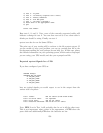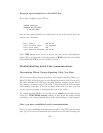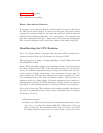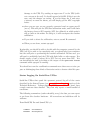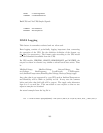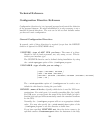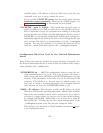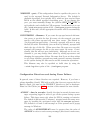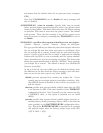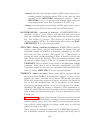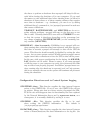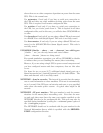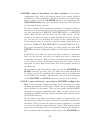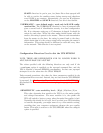
NISPORT <port> This configuration directive specifies the port to be
used by the apcupsd Network Information Server. The default is
platform dependent, but typically 3551, which we have received from
IANA as the official apcupsd networking port. If you change this
port, you must manually change the #define SERV
TCP PORT in
cgi/upsfetch.c and rebuild the CGI programs. An alternative is to use
the --with-nis-port= option of the ./configure program during the
build. In this case, all the appropriate locations will be automatically
changed.
EVENTSFILE <filename> If you want the apcupsd network informa-
tion server to provide the last 10 events via the network, you must
specify a file where apcupsd will save these events. The default is:
/etc/apcupsd/apcupsd.events. Currently, apcupsd will save at most
the last 50 events. Periodically (once an hour by default), apcupsd will
check the size of this file. When more than 50 events are recorded,
apcupsd will truncate the file to the most recent 10 events. Conse-
quently this file will not grow indefinitely. Although we do not rec-
ommend it, you may change these values by editing apcevents.c and
changing the appropriate defines. Be aware that if you set these values
to very large numbers, apcupsd may make excessive memory demands
on the system during the data access and file truncation operations.
This filename may also be specified at build time by using the
--with-log-dir= option of the ./configure program.
Configuration Directives used during Power Failures
In general, none of these directives are required. However, if you have a
voltage-signalling (dumb) UPS with a cable that does not support the Low
Battery signal, you must set the TIMEOUT directive to force a shutdown.
Please see the Cables (see Cables) section of this manual for more details.
ANNOY <time in seconds> Specify the time in seconds between mes-
sages requesting logged in users to get off the system during a power
failure. This timer starts only when the UPS is running on batteries.
The default is 300 seconds (5 minutes). apcupsd sends the annoy mes-
sages by invoking the apccontrol script with the annoyme argument.
The default is to send a wall message on Unix systems and a popup
message in Windows.
The value of ANNOYDELAY must be greater than the value of
ANNOY in order to receive annoy messages (this doesn’t make sense,
166




